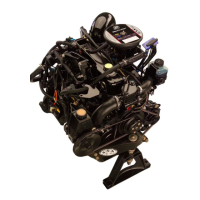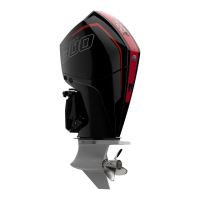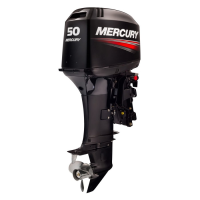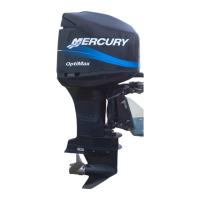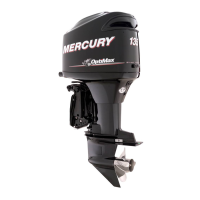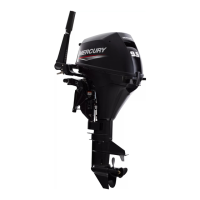ELECTRICAL - 2B-390-826148R2 MARCH 1997
Electrolyte Level
Check electrolyte level in battery regularly. A battery
in use in hot weather should be checked more fre-
quently because of more rapid loss of water. If elec-
trolyte level is found to be low, then distilled water
should be added to each cell until liquid level rises ap-
proximately 3/16” (4.8mm) over plate. DO NOT
OVERFILL, because this will cause loss of electro-
lyte and result in poor performance, short life and ex-
cessive corrosion.
CAUTION
During service, only distilled water should be
added to the battery, not electrolyte.
Charging a Discharged
Battery
The following basic rules apply to any battery charg-
ing situation:
1. Any battery may be charged at any rate (in am-
peres) as long as spilling of electrolyte (from vio-
lent gassing) does not occur and as long as elec-
trolyte temperature does not exceed 125° F (52°
C). If spewing of electrolyte occurs, or if electro-
lyte temperature exceeds 125° F, charging rate
(in amperes) must be reduced or temporarily
halted to avoid damage to the battery.
2. Battery is fully charged when, over a 2-hour peri-
od at a low charging rate (in amperes), all cells
are gassing freely (not spewing liquid electro-
lyte), and no change in specific gravity occurs.
Full charge specific gravity is 1.260-1.275, cor-
rected for electrolyte temperature with electrolyte
level at 3/16” (4.8mm) over plate. For most satis-
factory charging, lower charging rates in am-
peres are recommended.
3. If, after prolonged charging, specific gravity of at
least 1.230 on all cells cannot be reached, battery
is not in optimum condition and will not provide
optimum performance; however, it may continue
to provide additional service, if it has performed
satisfactorily in the past.
4. To check battery voltage while cranking engine
with electric starter motor, place RED (+) lead of
tester on POSITIVE (+) battery terminal and
BLACK (–) lead of tester on NEGATIVE (–) bat-
tery terminal. If the voltage drops below 9
1
/
2
volts
while cranking, the battery is weak and should be
recharged or replaced.
Winter Storage of Batteries
Battery companies are not responsible for battery
damage, either in winter storage or in dealer stock,
if the following instructions are not observed:
1. Remove battery from its installation as soon as
possible and remove all grease, sulfate and dirt
from top surface by running water over top of bat-
tery. Be sure, however, that vent caps are tight
beforehand, and blow off all excess water thor-
oughly with compressed air. Check water level,
making sure that plates are covered.
2. When adding distilled water to battery, be ex-
tremely careful not to fill more than 3/16” (4.8mm)
over plate inside battery. Battery solution or elec-
trolyte expands from heat caused by charging.
Overfilling battery will cause electrolyte to over-
flow (if filled beyond 3/16” over plate).
3. Grease terminal bolts well with Quicksilver 2-4-C
Marine Lubricant, and store battery in COOL-
DRY place. Remove battery from storage every
30-45 days, check water level (add water if nec-
essary), and put on charge for 5 or 6 hours at 6
amperes. DO NOT FAST CHARGE.
4. If specific gravity drops below 1.240, check bat-
tery for reason, and then recharge. When gravity
reaches 1.260, discontinue charging. To check
specific gravity, use a hydrometer, which can be
purchased locally.
5. Repeat preceding charging procedure every
30-45 days, as long as battery is in storage.
When ready to place battery back in service, re-
move excess grease from terminals (a small
amount is desirable on terminals at all times), re-
charge again as necessary and re-install battery.
WARNING
Hydrogen and oxygen gases are produced dur-
ing normal battery operation or charging. Sparks
or flame can cause this mixture to ignite and ex-
plode, if they are brought near the battery. Sulfu-
ric acid in battery can cause serious burns, if
spilled on skin or in eyes. Flush or wash away im-
mediately with clear water.
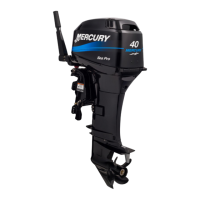
